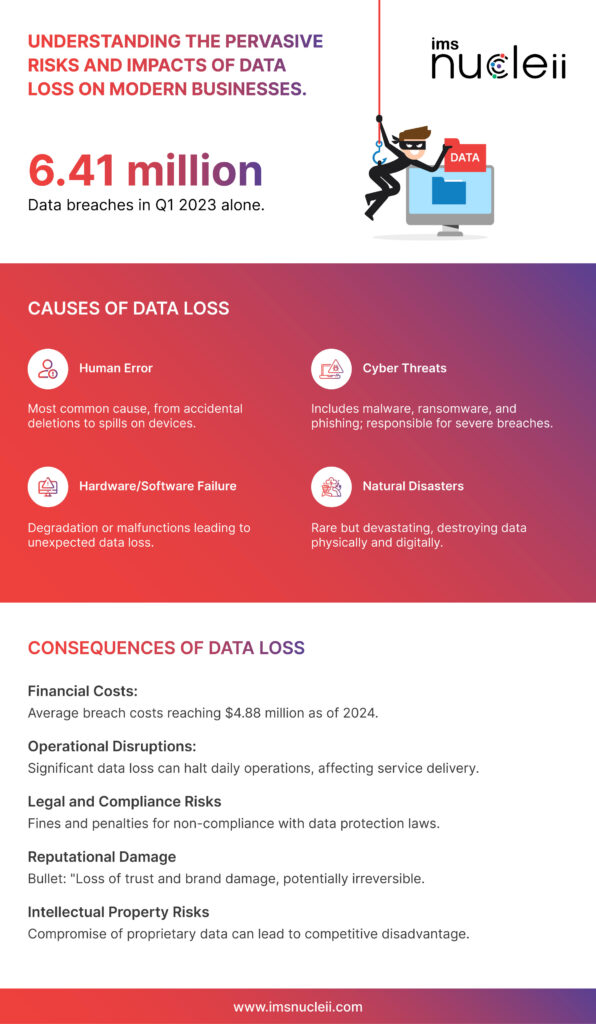“Data is synonymous with modern businesses.” Most businessmen or businesswomen would agree with this statement because every element of a modern organization, be it marketing or strategies – is data-driven.
However, this crucial element can cause a business’s downfall, too. A data breach alone can change the sentiments of not just users but the company’s investors. You may think it isn’t concerning. If you look at the number of data breaches in the first quarter of 2023, which was 6.41 million, you may reconsider your notion. Additionally, a breach is not the only form of data loss; destruction, deletion, and corruption are equally responsible.
Destruction and deletion can be intentional and unintentional. Some organizations delete & destroy unuseful data, but in other cases, hackers do it. On the contrary, corruption occurs when data becomes unusable due to storage, transfer, or processing errors.
Whether the data loss is due to technical failure, human error, or malicious attacks, it can halt operations and cause financial losses. Therefore, the life & death of your business depends on understanding the causes, impacts, and prevention methods thoroughly.

The Inevitability and Causes of Data Loss
Companies like Yahoo, Equifax, Facebook, LinkedIn, and various other big names have lost their data due to security breaches in the past. Mostly, there only a few reasons behind a data loss, such as:
- Human Error: We know that to err is human, but it’s not okay when it leads to data loss. Common mistakes such as accidental deletions or spilling liquids on devices are the prevalent causes behind numerous sizes of data loss. According to Statista’s survey, based in Saudi Arabia, 84% of respondents among Chief Information Security Officers (CISOs) agreed that human error was the biggest cyber vulnerability in their organizations.
- Hardware and Software Failures: Every hardware and software system is prone to degradation. For example, hard drive failure or corruption due to viruses, malware, bugs, or unfortunate crashes can lead to unanticipated data loss. Similarly, the cloud system or software can malfunction, and data can be lost.
- Cyber Threats: Malware, ransomware, and phishing are the leading causes of data loss. These threats, combined with human errors, cause the highest number of breaches. As per a study, in 2023, ransomware alone accounted for 70% of detected cyberattacks globally.
- Natural Disasters and Power Failures: Although these events don’t occur frequently, floods, fires, electrical outages, and other disasters do cause system failures, destroying critical data. Situations like floods, earthquakes, and fires can even wipe out entire data centers, leading to a complete halt in a company’s operations.
Economic and Operational Impacts of Data Loss
Losing business data is not something you can quickly get over with. These losses have profound implications, such as:
- Direct Financial Costs: Data breaches cost a huge financial burden as you not only lose your current revenue but also will have to invest many times more to bring your business back on track. As per Security Magazine, hackers target small and medium businesses most, and about 60% of them shut down within the next six months. Meanwhile, the global average data breach cost reached $4.88 million USD in February 2024, according to Statista.
- Operational Disruption: Businesses can sustain a loss of modicum data without causing any disruption. However, if the loss is significant, it can cripple your business’s daily operations. For instance, if a healthcare company loses patient records, their entire care unit will be at a halt because, without data, they won’t be able to further the treatments. Such situations cause companies to have the ability to make decisions and long-term strategic goals as their focus shifts to recovering old data or trying to handle the chaos.
- Legal and Compliance Risks: Laws like GDPR, HIPAA, CCPA, and more are formulated to protect user data, and businesses must abide by them. However, in case of a breach, these laws state the tragedy as negligence on the business’s end. They even impose huge fines on companies for not following the rules they have framed. For example, Amazon (€746 million) and WhatsApp (€225 million) have faced enormous financial penalties for violating GDPR guidelines.
Strategies for Prevention and Management
As per Security Magazine, about 25 percent of respondents rated their companies as “poor” or “fair” regarding the ability to detect and block threats. Follow these prevention methods if you don’t want to be among this percentage.
- Data Backup Solutions: Your company must have a double backup policy. In case of a mishap, your business can run with the help of secondary data storage. Further, you can also combine cloud-based and on-site backup systems so that when one system fails, data remains accessible and recoverable.
- Advanced Security Measures: Many businesses see firewalls, antivirus, and strong encryption standards as an unnecessary expense. However, it’s the opposite – these are the most essential elements to spend money on to protect your modern business. Advanced firewalls act as the first defense; strong encryption like AES 256-bit secures data, and antivirus detects malicious software, protecting every iota of your data.
- Employee Training and Awareness: If you don’t want humans to err and cause trouble, invest in educating them about new trends in data security. Encourage company-wide seminars on detecting and fixing vulnerabilities, identifying cyberattack attempts, and best practices to store data securely. CSO states that only 27% of companies currently conduct weekly data security training.
- Disaster Recovery Planning (DRP): Being resilient and having a contingency plan is equally crucial to reduce downtime. Your DRP must include –
- Clear protocols for data restoration
- Inventory of hardware & software
- Backup verification
- Storage and compute for failover and failback procedures
- System testing after recovery
Long-Term Consequences and Recovery
For small and medium businesses, long-term consequences can be shut down if data is not recovered. Meanwhile, the giant whales, like Yahoo, get over it, but with a blot on their brand image for a lifetime.
- Reputational Damage: Data is as precious in the contemporary world, and you lose your identity somehow if that gets stolen. Therefore, when users witness their data being stolen for whatever reason, they start doubting, and that trust starts eroding, causing a company to lose financially over time. Travelex is one of the most recent examples of how a breach can cause your company to succumb. They tried to revive the brand for eleven months until it went into administration.
- Intellectual Property Risks: If your company’s proprietary research, patents, designs, strategies, or programs are compromised, they may face duplicity issues. Their ideas or innovations could be copied by competitors and sold for less. You won’t be able to take legal action until you have data as evidence to prove the innovation belongs to you.
- Case Study: Microsoft is one company that caused a massive global disturbance after over 30,000 US businesses were affected by sweeping attacks on the Microsoft Exchange email servers. It took Microsoft three months to patch the vulnerabilities because systems weren’t on the cloud.
Protection Is Always A Smart Choice!
This article serves as a reminder that not every business can survive the severe consequences of a data breach. It is necessary to reevaluate your data protection measures at every step and to Ask yourself – Are you doing enough to secure your and your user’s data? If not, then it is never too late to take the right step.
For in-depth insights on best data protection practices, explore IMS Nucleii’s whitepapers – “Security Patching Made Simple: A Guide for Busy Businesses” and “The Future of Cybersecurity: Trends and Predictions for the Next Decade.”












